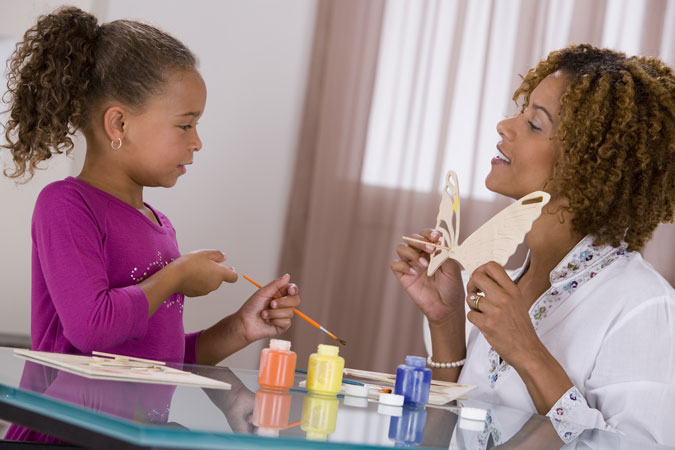 Thanks to the folks who shared some excellent advice for catechists of primary age children last week! This week, we turn our attention to those who teach children in grades 4, 5, and 6 – the intermediate grades. What works? What doesn’t work? What approaches are most effective? What skills, techniques, and strategies are needed?
Thanks to the folks who shared some excellent advice for catechists of primary age children last week! This week, we turn our attention to those who teach children in grades 4, 5, and 6 – the intermediate grades. What works? What doesn’t work? What approaches are most effective? What skills, techniques, and strategies are needed?
Allow me to begin since I taught 4th graders last year!
My advice? Don’t “baby” this age group. They have enormous amounts of energy and enthusiasm and their capacity to learn is exploding. Feed off of their energy and have fun with them. Give them lots to do and keep expectations high. Use their willingness to participate to your advantage for lots of engaging activities.





Ditto. I teach 6th graders and tell them up front I will treat them as adults as much as they let me. Most of the time they rise very well to the occasion.
I also love working with intermediate children. I’ve taught fourth grade for a number of years and found the children so ready and willing to learn about the Catholic faith. They love doing posters, dioramas, role playing, group work…I even gave them opportunities to be catechists. Wow! That was an awesome experience! One particular unit of study on the Way of the Cross turned out to be something which I thought went beyond their years. They created the Way of the Cross with props, costuming, etc. but gave it a contemporary twist. It was amazing.
A great and challenging age! They can begin to think, question and reason… I find that they still love the stories but now they can begin to identify with the people in those stories. I concentrate a lot on Peter because he is so like us in so many ways and, look what Jesus had in store for him (and them!!). They have tough questions that deserve honest answers even if the only answer is ‘I don’t know’. The best question I ever got was from a 4th grader who asked, “If God didn’t want us to eat from that tree (Eden) then why did he put it there to begin with?” They are straightforward and to the point. They want to believe but sometimes struggle with ‘blind faith’ – it has to make sense to them. I think my best advice is to be ‘real’ and to lead by example not words!
The middle grades are great fun to teach. I always encourage them to get to know (often they are from different schools) and acknowledge each other (and help if necessary) when they see one other in town. I provide a black and white composition notebook on the first day of class for recording prayer intentions. The notebook is passed around during class and students write down their prayer intentions for the week-one student reads them during the end of class prayer time at the prayer table. It is a nice way to keep connected with what is going on in their lives-sick grandparents or family members, as well as let them know what is going on in your life a bit. Sometimes you find students looking back through the pages over the year of prayer intentions. Keep the Faith!!!
I love this idea and will definitely try to implement this next year in my class!
This is my favorite age to work with, as they have so much to offer us! I have found that is so important to set a tone of respect for all. How I meet and greet is the first indication to each individual that they are important. To set a prayerful environment I have asked the children to take their shoes off outside the door and then I emphasize that they are on holy ground as they enter the room. Using a hushed tone and playing meditative music as they enter can set a wonderful atmosphere to “huddle up close” for prayer.
I’ve been teaching 5th grade for about 9 years now. 5th graders are still children but probably don’t want to be reminded of that. With that said, they still like to play so engage them with music, games and story telling. They love acting out gospel stories. They still like crafts at this age too. I believe our children grow up way too fast so don’t forget to challenge them, but also do fun things.
I am a CRE at my parish and we combine 4th/5th graders together to fit all of our elementary children into our classrooms. One group was being very difficult, not listening, talking and generally not cooperating with each other. The teachers divided them into small groups, gave each group an objective, and they had to teach it to the class. The teachers guided each group if needed. The kids were all over it! The students did a great job teaching while also learning what they had to teach with the added benefit of realizing how difficult it can be for their teachers. We never had a problem with that group again.
I will be starting my 3rd year as a 4th grade cathechist. My experience so far has shown me that the students are more likely to be engaged when they are given opportunities to lead and to actively participate. Connecting Christ’s teachings of love, compassion and service, to their real life experiences with their families, schools and community helps guide their understanding of our faith. Also, when class gets a little too”busy”, a session of guided meditation and prayer really helps bring the students focus back.
I have found that breaking the 1 hour class per week into different segments keeps their attention more. We have a ritual each week of a 1-2 minute review of what happened last week. I review the 10 Commandments almost every week as they are so central to our faith and we says prayers to end the class (even if parents are waiting). I play games with them and they enjoy the challenge of finding verses in the Bible and reading it outloud. You have to ask them upfront how they feel about role playing and let them know they are able to feel safe with any questions they ask in the classroom. It should be a place where they can question things (afterall, it is quite likely that this may be the only time faith is discussed). DO NOT SHOW THEM CARTOON DVDs. They are too mature for them. The DVD, Jesus of Nazereth, was a very profound movie for them and it stuck with them weeks later.
I have been teaching six grade for about nine years. The most important thing i have learned is to keep the lesson interesting and to make fun for the students. My students come to class after spending all day in a public school classroom and they are ether tired, or they are charged up on sugary snacks. So you have to make the lesson interesting ,and also fun for them.
All students like to know what to expect. Organize your time and be consistent) in routines (this doesn’t mean boring); tell them what the goal is for your time (ie learning about different kinds of prayer); have them help you set the standards for your class and learning time (great place to teach about doing unto others how you want to be treated.) Engage the students in team building activities that have a goal (builds community); create interdependence through activities that allow them to use each other’s experiences and knowledge.
Wow! I can’t thank you all enough for coming through with these amazing insights! I can’t wait to share them during my webinars! Thanks so much!
I tell this age group every class will have four components – community (fun and helping each other); content (stuff we need to know); worship ( saying thank you and I love you to God); and prayer (a conversation with God, Jesus, Holy Spirit). At the end of every class I ask them to tell me where and how this happened in class and elsewhere in their lives. I find they love talking, presenting, pretending, and creating. At least once I try and have something they have made on display at the entrance to a Sunday Mass. They love seeing their stuff prominently displayed.
I can’t agree more with the comments above. Intermediate grades can be alot of fun to teach. They still like some of the younger type activities but they are ready to take on more responsibilites. One thing we have done in our program is let them be “buddies” to the kindergartern/preschool classes. We have them team up with a child and they sit with them when we have gatherings, help them make the sign of the cross, and keep their attention focused to what we are doing. It is a positive experience for both the middle grader and the younger child. I also encourage ice breakers or activities that let them get up from the table or desk and move around. Let them use their creativity. One of the things I have done in many of my grades is when we are group reading the children just read one sentence and then it goes to the next person. This works for two reasons, it keeps the children on their toes and paying attention to where we are at, however it also allows the children that struggle at reading to participate but they are not struggling to read a whole paragraph. Hope some of this helps!
Thanks for all the wonderful ideas! I’ll add mine for this group–guided meditations (the first time may not be a great success, but keep at it–soon they’ll be begging for one every week!), service activities (especially outside the classroom, but even in class work very well), and always read Bible references directly from the Bible, not just the textbook. We also have Advent and Lent “Activity Lessons” when catechists each prepare a 20-minute workshop and the kids rotate to these workshops and go home with lots of materials to help them better celebrate the season.
I taught 6th grade class, focusing on the Old Testament, for about 10 years. Loved the comment about taking their shoes off – I did the same thing & the kids loved it! They are bright and inquisitive. They will ask many questions, so keep your Catechism handy. I also invited our priest during each year for a Q & A, and they were able to ask anything they had a question on reqarding their faith. It was always enjoyable.
We also used a lot of acitivities: we did an “Oprah” show interview of the people of a Bible story, a commercial for listening to the prophets, we played “Who wants to be a 5-dollinaire”, “Stump the Teacher”, and “Concentration” using Old Testament symbols like those from the Jesse Tree.
When we read, we used things like “Popcorn”, tossing a small foam ball to the next reader, or having the class split and each half take turns reading a paragraph. Keep them engaged, show your enthusiasm and love for what you teach and they will too!
Planning sessions for the intermediate age group is key. Gotta keep their attention and challenge their growing brains and personalities. What I discovered quickly that HANDS ON helps this age group. Trips to the Stations of the Cross, Sanctuary area, Reconciliation Room (which they may have forgotten from their First Reconciliation), and discovering the sacramentals in the Church especially at their parish! Do not underestimate the power of competition. I often use blackline master quizzes or activities as a competition and watch them thrive. And then there is PRAYER—they totally enjoy the “going to their HEART HOME” and finding a place to sit with Jesus.
Hi Joe — I have been a catechist for 14 years — primarily with grades 4-6. Since we mix our grades there are natural leadership opportunities for the 6th graders to teach the 4th graders how to plan our Communal Prayer or Rosary Service each week.
Our curriculum is a mix of Bible Study, Sacraments and Prayer. I think it is important to allow each student the chance to read aloud (they can always say “pass” if they don’t want to) or respond to a Meditative question related to the lesson. Those discussions are the best because the students have tremendous insights about their relationship with the Good Shepherd and what it means in their day to day lives. For example, we study the Maxims and during the discussion we talk about how they can be applied at school, at home, on the playground.
I think it is important for the catechist to be the humble servant to the child. Foster the type of environment where the Holy Spirit is welcomed and embraced (and get yourself out of the way!).
Finally, one of the best “group” projects that I’ve ever witnessed was led by one of my 6th graders (he is now in 10th grade and being confirmed this year) who encouraged the entire class to help him create a giant paper (cardstock — Yellow/Cross/Apostle’s Creed, Blue/Our Father, Pink/Hail Mary, Green/Glory Be, Purple/Hail Holy Queen) rosary. Each prayer of the entire rosary was handwritten by everyone in the class as a meditative exercise and offered for a particular intention. He used a stapler to create a paper bead of each prayer and then used a hole punch and yarn to “string” the beads and cross together. This project took months and it was exciting to see it being constructed each week.
Good luck with the upcoming Webinars! I am looking forward to meeting you at the upcoming ACRE seminar on Sept. 15 at Holy Name of Jesus in Wayzata!
Best Regards,
Karen
Great comments from the catechists and C/DREs!
You can really have a LOT of fun with the kids at this age –
skits and Gospel playlets, projects (like dioramas, posters, etc.), games (incorporating those readily available online like Stump the Shepherd from Christ Our Life – or formats that are downloaded and can be used on a powerpoint/LED projector).
Years ago when WHO WANTS TO BE A MILLIONAIRE? was really popular, we did WHO WANTS TO BE A SAINT? – which somebody actually had online.
In fifth grade, we did a VERY simplified Seder Meal using materials from LTP to coincide with the lesson.
I’m in my 9th yr w/5th grade. My biggest challenge is keeping them focused & interested b/c they are coming to us tired & antsy @ the end of their school day. Often my students do not attend mass, so I do like to cover at least the Gospel message from each Sunday’s mass.
The start of each class I have a short Scripture quote on the board, which they copy down, along w/a warm-up…maybe a scripture word search or word scrambler for them to focus in as soon as they come into class. Once class begins we discuss the Scripture quote, do they think it’s from Old Test or NT & why? What they think the quote means & who may have written it.
I always like to think up some “hands-on” activity to enhance a point. For example, I’m big on just be kind, treating everyone w/respect. In an effort to make this visible in a new way I tried this. I have an empty pan. I ask for a “God” volunteer who then pours a bottle of water into the pan…to symbolize God creating the world. Another volunteer, the “devil” then sprinkles pepper over the water surface to symbolize evil spread onto God’s world. The final volunteer is the “angel of kindness” who drops a few drops of kindess (dish detergent) over the peppered water. Suddenly the kindness chases away the evil!
I also try to incorporate a few minutes of silent prayer. This is especially useful when class is out-of-sorts, it calms them for a minute or so. LOL
Speaking of laughing, a huge, loving heart & a gigantic sense of humor help transform us into the people Christ invites us to be –esp. when sharing God’s word w/our children:)
Treat the little men and women with the same respect you expect of them.
They are trying to find their identity before they go into the they know
everything 6th grade. Take an interest in their spiritual as well as personal life.